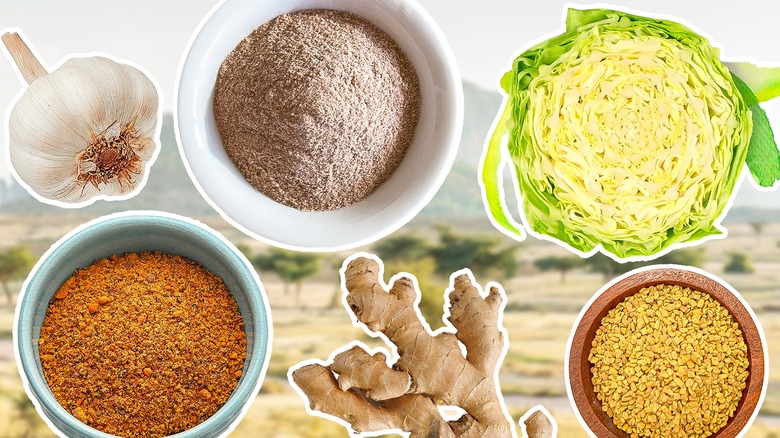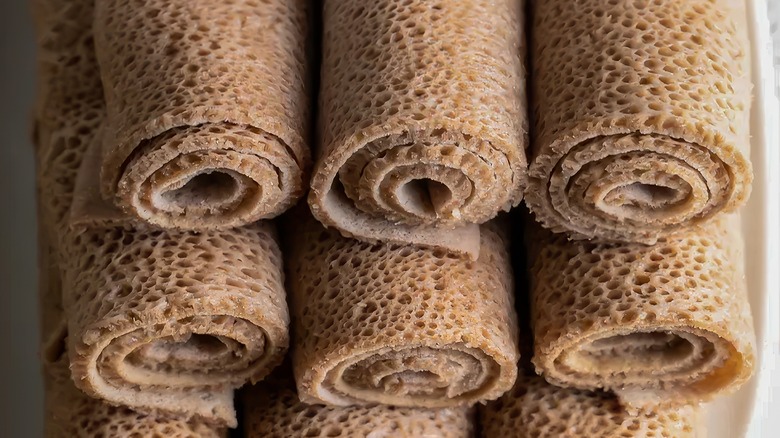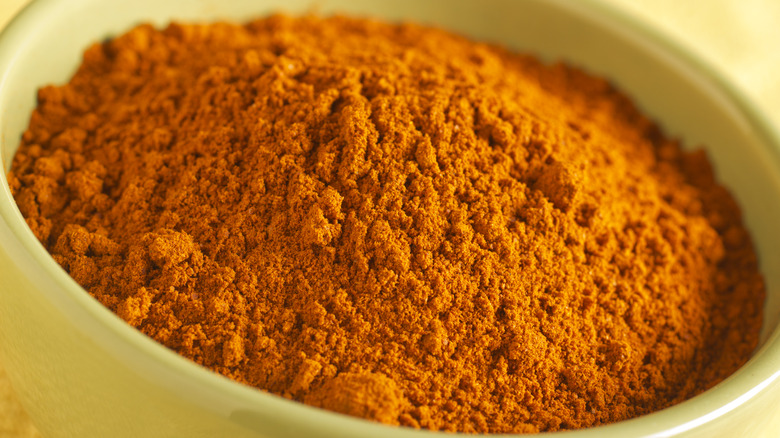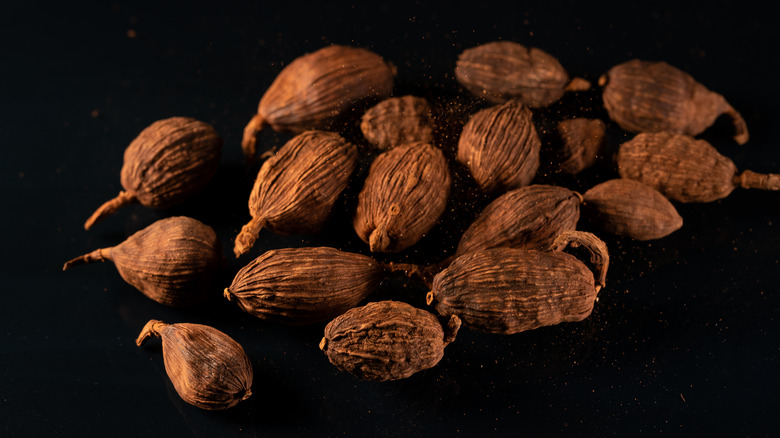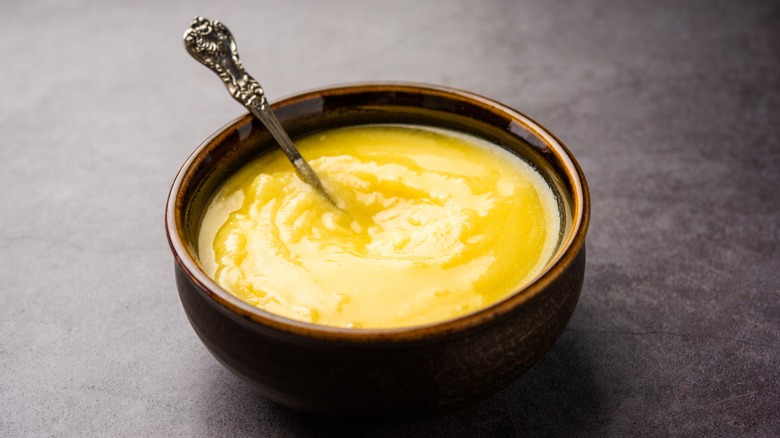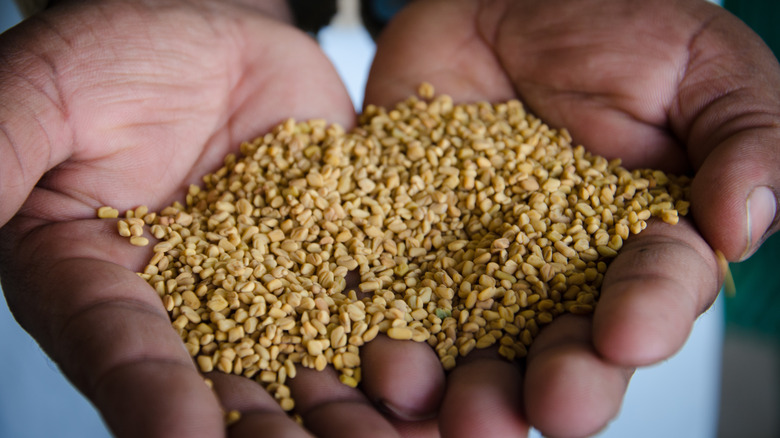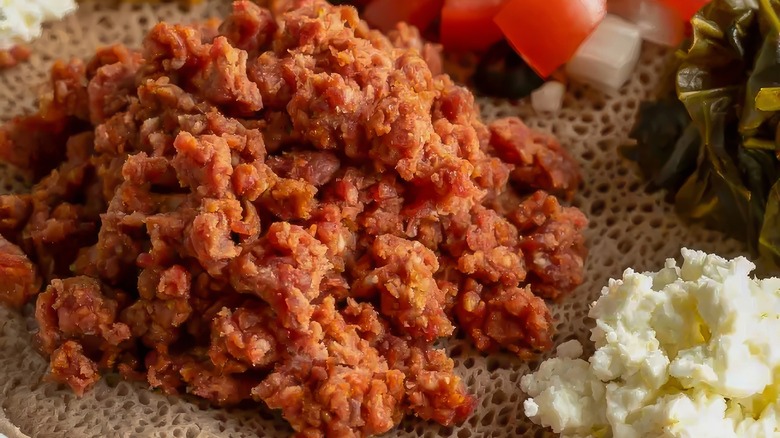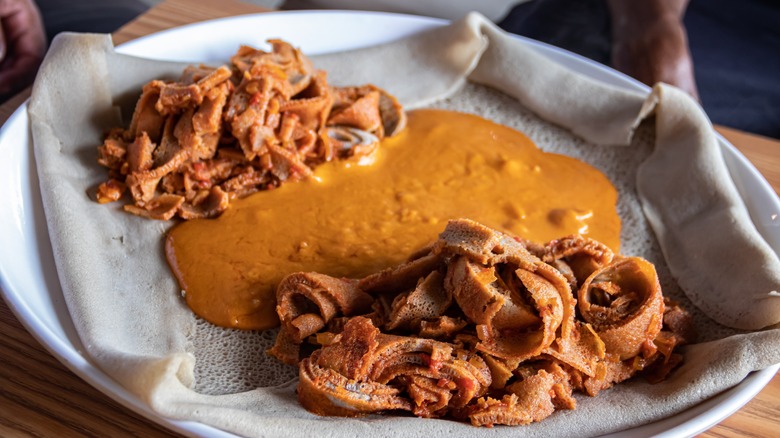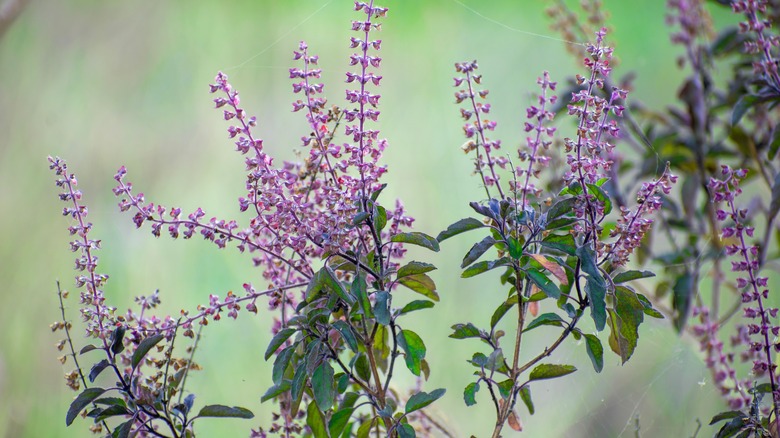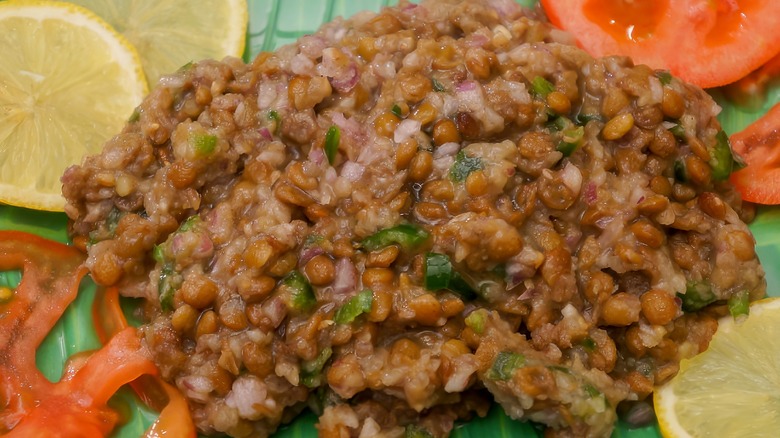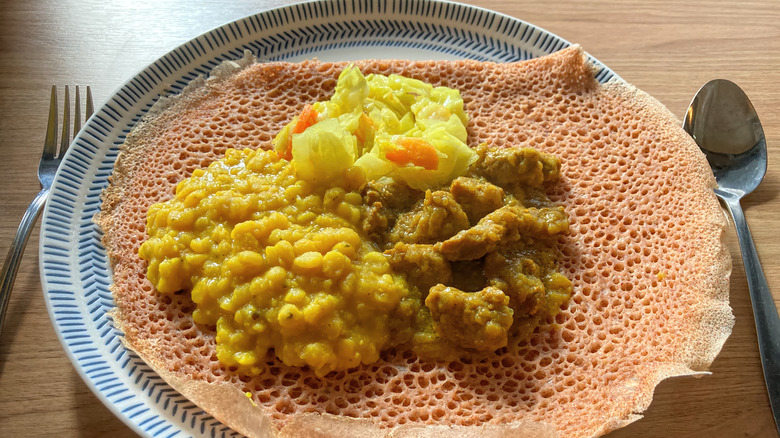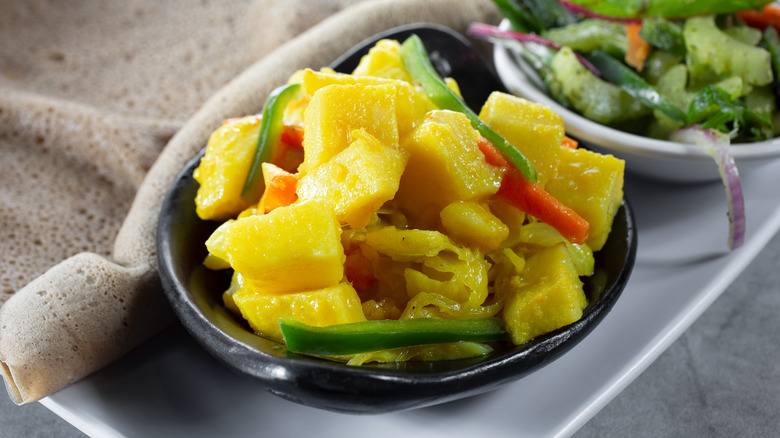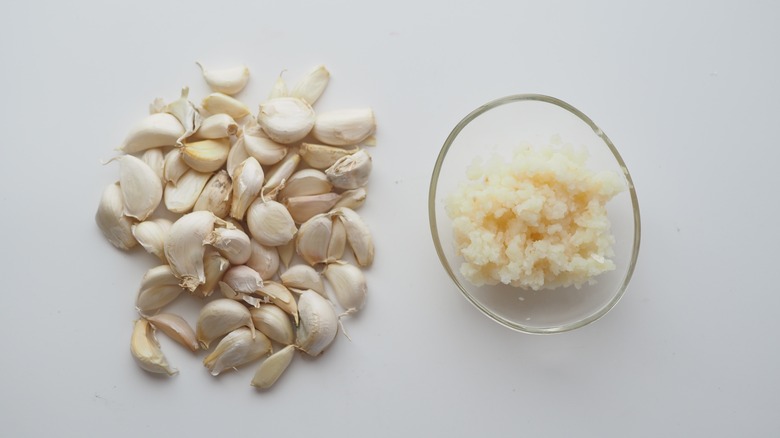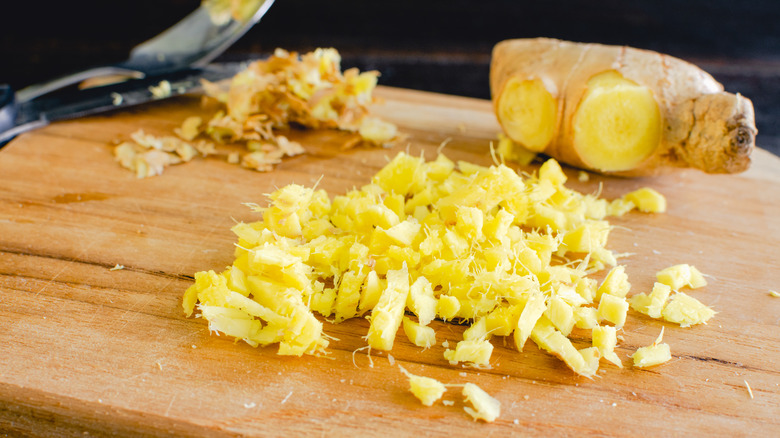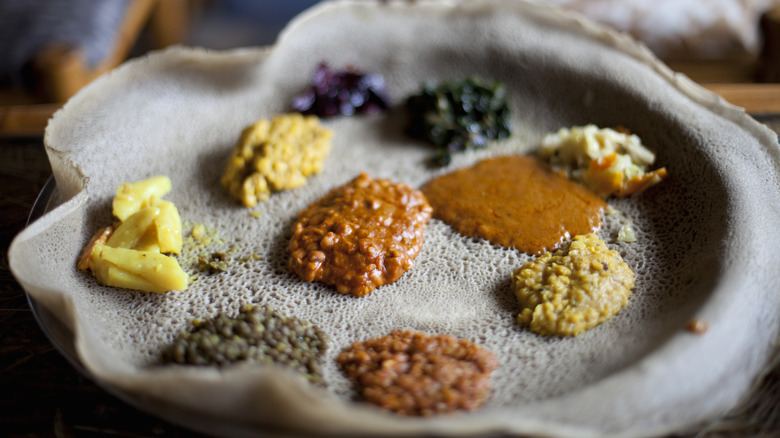13 Essential Ingredients You Need To Make Great Ethiopian Food
As the birthplace of coffee and one of the first culinary traditions to make honey wine, Ethiopian cuisine is a journey into the past and across the globe. If you're trying your hand at cooking this unique cuisine at home, then there are a few ingredients that can help set you on the path to success. These are the essential ingredients you need to make great Ethiopian food.
Ethiopian cuisine offers diners a unique blend of aromatic spices with simple, hearty ingredients, most often prepared over an open fire. Traditionally served on a large platter covered with injera — a spongy sourdough flatbread made out of teff flour — Ethiopian meals are communal affairs where diners use pieces of injera to scoop up various stews and vegetables.
I have researched Jewish Ethiopian food extensively when working on a Passover cookbook a few years ago, and what I discovered changed the way I cook many vegetables and legumes. Ethiopian cooking relies on a distinctive set of ingredients and techniques that helps create its characteristic bold, complex flavors. From the fiery berbere spice blend to the earthy teff flour used in injera, each of these essential ingredients plays a crucial role in building the rich, layered flavors of Ethiopian dishes. Mastering these techniques and components will help you bring these incredible flavors into your kitchen.
Teff flour
Teff flour is a crucial ingredient in Ethiopian cuisine. It's the key to making injera, the traditional Ethiopian flatbread on which most other food is served. This gluten-free flour comes from teff, a tiny grain native to Ethiopia.
Teff has a unique, slightly nutty flavor. It's packed with nutrients like protein, fiber, calcium, and iron. The different grain varieties produce different types of flour, with brown teff flour and ivory teff flour being the most common. Each offers a slightly different taste profile, but in most international markets you will be lucky to find just one kind. You can also buy teff flour online.
Cooking with teff flour requires some practice. To make traditional injera, teff flour is mixed with water to create a batter that is then fermented similar to the way you would ripen a sourdough starter to make bread. You can also use teff flour in other recipes to add nutrition and a unique flavor. It works well anywhere you would use buckwheat flour, adding a special nutty aroma and texture.
Berbere spice mix
Berbere is an essential Ethiopian spice blend that forms the backbone of many dishes. This fiery and aromatic mixture typically includes chili peppers, garlic, ginger, and various aromatic spices like fenugreek, coriander, cardamom, nutmeg, which gives it a woody and slightly bitter flavor, and cinnamon, a spice that has a mystical history in the region. Each region and sometimes even each family will have its own unique berbere recipe, with slight nuances in the spices used and the ratios for them.
You can buy berbere spice mix in some specialty spice stores or stores carrying Ethiopian ingredients, but creating your own berbere blend allows you to customize the flavors to suit your taste preferences. For example, you can adjust the heat level by varying the amount of chili peppers used, ensuring your don't burn your mouth upon your first trial with this cuisine.
When making berbere at home, first find a recipe you like. For best results, you should use whole spices where possible and toast them before grinding them. This step releases the essential oils and creates a more fragrant blend. You can then store the whole spices in a jar, grinding only as much as you need to keep them fresh.
Korerima (Ethiopian cardamom)
Korerima, known as black or Ethiopian cardamom, is a vital spice in Ethiopian cuisine. Native to southwestern Ethiopia, this member of the ginger family has been used for centuries in traditional dishes. The seeds of korerima possess an astringent and tangy taste, releasing a distinctive aroma when ground. This complex flavor, with notes of citrus and camphor, is the backbone of a lot of Ethiopian and even some Indian dishes.
In Ethiopian cooking, korerima is valued not only for its taste but also for its perceived medicinal properties. It's commonly used as a key ingredient in berbere spice blends, niter kibbeh (spiced butter), and various stews and soups. It also works great as a supporting actor in spice rubs for meats and vegetables.
Clarified butter (niter kibbeh)
Clarified butter, known as niter kibbeh in Ethiopian cuisine, is an essential ingredient that plays a crucial role in defining the unique flavors and aromas of many Ethiopian dishes. This golden, spice-infused butter is more than just a cooking fat; it's a flavor powerhouse that adds depth, richness, and complexity to a wide range of recipes.
The process of making niter kibbeh involves slowly simmering butter with a blend of aromatic spices such as cardamom, coriander, cumin, turmeric, and garlic. This infusion gives the butter a distinctive taste and fragrance, the foundation for many Ethiopian dishes. The clarified butter helps to bloom and activate the flavors of other spices used in Ethiopian cooking. The clarification process also removes milk solids, resulting in a pure butterfat with a higher smoke point, making it ideal for cooking at higher temperatures.
Niter kibbeh is used in various ways in Ethiopian cooking. It's often used as a base for stews, added to sautéed dishes, and used to finish and enrich many recipes. It's also the key ingredient in kifto, a raw meat dish that is the Ethiopian answer to tartare.
Niter kibbeh also serves practical purposes. As some Ethiopian tribes are nomadic, and the whole country lives in very hot conditions, a butter with a longer, more stable shelf life is a valuable ingredient in a cuisine that traditionally lacked refrigeration. The spices used in its preparation are also believed to have preservative properties.
Fenugreek
Fenugreek, or abish in Amharic, is known for its subtle bitterness and slightly sweet, nutty flavor with hints of maple syrup. This versatile spice is used in two primary forms: whole seeds and ground powder, and is a common component in clarified butter, Ethiopian fenugreek-flavored water and fenugreek candy. It's also been added to injera since antiquity, and remains a typical ingredient to this day.
In Ethiopian cuisine, whole fenugreek seeds are lightly toasted before use to enhance their flavor and aroma, while ground fenugreek is used in spice blends like berbere. If you're just starting out with Ethiopian fenugreek, soak it at least an hour before using, to mellow out its flavor. It's the perfect component in Ethiopian lentil dishes, cabbage stew, known as wat, and even in honey cakes.
Mitmita spice
Mitmita is a fiery Ethiopian spice blend that adds intense heat to dishes. You'll find this vibrant red-orange powder in Ethiopian grocery stores or specialty spice shops. The main ingredient in mitmita is dried chili peppers, usually African bird's eye chilies. These tiny peppers pack a serious punch of heat. To balance the spiciness, mitmita also includes aromatic spices like Ethiopian cardamom, cumin, and cloves.
You can use mitmita to season raw or cooked meat dishes. It's particularly popular sprinkled on kitfo, a dish of minced raw beef. The spice blend also adds depth to stews, vegetables, and lentil dishes.
If you're feeling adventurous, you can try making your own mitmita at home for the freshest results. To create your perfect blend, toast and grind whole African bird's eye chilies, cardamom, cumin, and other spices. You can then store it in a sealed jar in a cool, dark place to keep the essential oils inside from activating and losing their potency.
Shiro powder
Shiro powder is one of the most unique ingredients in Ethiopian cuisine, consisting of ground chickpea flour and various spices. It forms the base of shiro wat, a popular Ethiopian stew.
To make shiro powder at home, you'll need chickpea flour as the main component. Roast the flour in a dry pan without any oil. Then, season the flour with berbere spice, ground cardamom, cumin powder, and garlic powder, and you've got yourself shiro powder. Some shiro powder recipes include additional ingredients like ground dried onions or fava beans, but these are not wholly necessary.
Once you have your shiro powder, you can add it sautéed onions and tomatoes. Gradually stir in water to create a smooth consistency, add chickpeas and cook. The result is a thick, creamy chickpea stew that is perfect for serving with injera bread. Shiro powder, like the majority of most Ethiopian food, is low in fat while being high in protein and fiber, making it an excellent option for vegetarians and vegans.
Besobela (sacred basil)
Besobela, also known as Ethiopian sacred basil, is a unique herb essential to authentic Ethiopian cuisine. Unlike common basil, it has a distinct flavor profile with strong minty undertones, a surprisingly warm clove-like taste, a slight anise flavor, and a peppery kick at the end.
You'll find besobela used in several key Ethiopian preparations. It's a crucial ingredient in niter kibbeh, the spiced clarified butter that forms the backbone of many Ethiopian dishes. The herb imparts a complex, aromatic flavor that's difficult to replicate with substitutes. If you're aiming for authentic Ethiopian flavors, sourcing real besobela is worth the effort.
If you can't find besobela, some cooks suggest using a mix of basil and oregano as a substitute. However, keep in mind that this won't perfectly replicate the unique flavor of true Ethiopian sacred basil.
Lentils
Lentils are a cornerstone of Ethiopian cuisine, featuring prominently in many beloved dishes. You'll find red lentils used in misir wat, a flavorful and hearty stew that's a staple on Ethiopian tables, as well as azifa, a salad of cooked lentils with chopped vegetables and peppers. The most commonly used lentils in Ethiopian dishes are red and green lentils.
When preparing Ethiopian lentil dishes, start by rinsing and sorting your lentils. This helps ensure you remove any debris or stones from your legumes. Soaking lentils for 30 to 60 minutes can also reduce cooking time and improve their texture.
Don't be afraid to experiment with lentils alongside different spice combinations to find your perfect flavor profile. For example, red lentils go very well with berbere, while green lentils are a perfect bed for highlighting the pungent, earthy flavors of garlic and ginger.
Cabbage
Cabbage is a versatile ingredient in Ethiopian cuisine and one the key components of any typical Ethopian spread. Unlike in the west, cabbage is not just a side dish in Ethiopian cuisine. It often takes center stage, providing a hearty and satisfying base for stews and Ethiopian stews, called wats.
In Ethiopian food, cabbage is most commonly paired with potatoes, carrots, onions, garlic and turmeric. You'll find cabbage featured prominently in dishes like atakilt wat, a popular vegetable stew. Tikil gomen is another beloved Ethiopian dish that showcases cabbage alongside potatoes and carrots.
To prepare Ethiopian-style cabbage, you'll want to chop it into thin strips. This allows it to cook quickly and absorb the flavors of other ingredients. Then, you'll want to sauté your cabbage briefly. This keeps it tender-crisp rather than mushy. Typically, cabbage is added near the end of cooking, allowing it to retain its texture and vibrant color.
Potatoes
Potatoes add heartiness and texture to a variety of Ethiopian dishes, helping bulk up and make several recipes more filling. Their versatility and ability to absorb flavors make them a popular ingredient in many traditional recipes, such as tikil gomen and beet and potato salad, called key sir alicha.
For Ethiopian dishes, choose waxy potatoes like red or yellow varieties, as they maintain their shape well during cooking without becoming mushy. Wash and peel them, then cut them into 1-inch cubes and rinse to remove excess starch. This preparation allows the potatoes to cook evenly and absorb the rich spices and sauces.
In Ethiopian cooking, potatoes are often sautéed with onions, garlic, and spices before being incorporated into stews or side dishes. Their blandness means that they pair beautifully with both spicy meat dishes and vegetarian options.
Garlic
Garlic is one of the building blocks of many international cuisines, and Ethiopian food is no exception. It adds a sweet undertone, a hint of spice, and a tangy smell and flavor to many Ethiopian stews, sauces, and marinades.
Ethiopian cooks use garlic in its raw form, finely minced or crushed. This releases its potent oils and creates a strong, pungent flavor that's characteristic of many Ethiopian dishes. When cooking Ethiopian food at home, choose fresh garlic cloves rather than pre-minced versions for the strongest flavor possible.
In combination with other spices, large quantities of garlic form the backbone of many Ethiopian flavor profiles. It's frequently paired with ginger, onions, berbere spice blend and black cardamom. You'll encounter garlic in popular Ethiopian dishes like doro wat, a spicy chicken stew, and misir wat, a red lentil dish. And don't just stop at two cloves — Ethiopian recipes often call for two whole heads, or a minimum of six cloves in a single dish. Just don't overdo it to avoid damaging the liver.
Ginger
Ginger helps add warmth and a special smell to many dishes. Similarly to Asian food, you'll find this versatile root used in both savory and sweet Ethiopian recipes. Beyond its culinary uses, ginger is valued in Ethiopian culture as it's believed to aid digestion and boost immunity.
Fresh ginger is preferred in Ethiopian cooking. When shopping, look for firm roots with smooth skin. Avoid any pieces that feel soft or show signs of mold (you can store ginger for a while in the fridge and even the freezer with a few simple tricks). To prepare ginger for Ethiopian cooking, you'll need to peel the skin using a spoon's edge before grating or finely chopping it. The peel is considered dirty and is seen as taking away from the subtle flavor, so it will usually be discarded before proceeding.
Ginger is a key component of many Ethiopian spice blends, including berbere and mitmita. It's also used in Ethiopian spiced clarified butter. You'll often combine ginger with garlic and onions to create a flavorful base for many popular Ethiopian recipes.
Famous Ethiopian dishes
Now that you're familiar with the essential ingredients and building blocks of Ethiopian food, I hope that you feel ready to take on this new and exciting culinary challenge. Many famous Ethiopian dishes incorporate these essential ingredients like teff flour, berbere spice blend, and shiro powder, and we'd like to get you started on some of the main ones. Though not easy to make in its traditional form, injera, a spongy flatbread made from teff flour, has a speedier adaptation that helps make the foundation for most Ethiopian meals more accessible to the home cook.
Some popular Ethiopian dishes include doro war, a spicy chicken stew with berbere spice. Misir wat is a dish of red lentils cooked with berbere and spices, but we also love making this with split peas. Tibs is a dish of sautéed meat (beef or lamb) with vegetables, while tere siga is its raw cousin. And beef kitfo is a dish of minced raw beef seasoned with mitmita spice blend that we just can't get enough of.
But don't worry; vegetarian options are also abundant in Ethiopian cuisine. You'll find dishes like gomen (collard greens), tikil gomen (cabbage and potatoes), and fosolia (green beans and carrots) on many menus. They can also be a great introduction to Ethiopian cooking for many home cooks. Arm yourself with some recipes, a trip to a well-stocked store, and a spirit for exploration — but leave your misconceptions and closed mind at the door.
